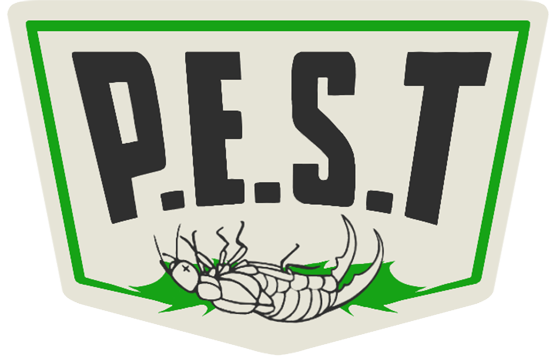Imagine the telltale signs of rodent activity in your home or business: gnawed wires, droppings along baseboards, and the faint rustling of tiny feet in the walls. Such indicators are not only unsettling but signal a potentially serious pest issue. Welcome to Premiere Exterminating Solutions Team (P.E.S.T.), where our expertise in effective rodent eradication and control stands unmatched. This page is dedicated to educating you about the prevalent rodent issues in Northern Central Indiana and illustrating how our targeted solutions at P.E.S.T. can restore safety and peace to your environment. Let us guide you through understanding, detecting, and resolving rodent infestations with precision and efficiency.
Most Common Pest Rodent Species
- The house mouse is relatively small, featuring a slender body, a pointed nose, and large ears, with fur that varies in color from light brown to dark grey. This rodent is particularly known for its ability to squeeze through extremely small spaces, making it a common intruder in homes. They are omnivorous, showing a strong preference for cereals and grains, which often leads them into kitchen pantries and storage areas where food is abundant.
- Larger than the house mouse, the Norway rat has a robust body and a blunt nose, with a coat of brown fur interspersed with black hairs. Renowned for their swimming abilities, Norway rats are often found in damp environments and are known to establish burrows alongside building foundations, beneath piles of garbage, or under woodpiles. These rats are a notable concern due to their ability to damage structures and spread diseases.
- The roof rat possesses a slender build with a body longer than that of the Norway rat, complemented by large ears and a long, scaly tail. These rats are agile climbers, often nesting in high places like attics or upper floors of buildings. They have a varied diet but show a particular fondness for fruits, nuts, and grains, which can draw them to residential areas where such food sources are plentiful.
- Distinctly bi-colored, the deer mouse has a white belly and legs that contrast with its brown or black back. It is notorious for being a carrier of the hantavirus, posing significant health risks. Deer mice prefer wooded areas and typically only invade residential homes when these structures border forested regions, seeking shelter during colder months or when food is scarce.
- The meadow vole is characterized by its small, stout body, short legs and tail, and dense brown fur. Primarily found outdoors, these rodents are notorious for causing extensive damage to lawns and gardens as they feed on a variety of grasses and plants. Their outdoor nesting habits and dietary preferences can lead to significant landscaping challenges for homeowners and garden enthusiasts.
Health Threats And Signs Associated With Rodent Infestations
Rodent infestations pose severe problems ranging from health risks to physical damage and contamination. These pests are carriers of numerous dangerous diseases, including hantavirus, leptospirosis, and salmonellosis, which pose significant health threats to humans. The physical damage caused by rodents is also extensive, as they are known to chew through wires, which can lead to electrical fires, gnaw on insulation, and cause structural damage to buildings by undermining the integrity of wooden elements and pipes. Rodents are also notorious for contaminating food supplies, which can lead to serious economic losses, particularly for businesses involved in food service or production. The presence of rodents can compromise the cleanliness of food preparation areas and lead to the spread of foodborne illnesses, highlighting the critical need for effective rodent control measures.
Signs of a rodent infestation include the discovery of dark, pellet-shaped droppings in kitchen cabinets, drawers, or along baseboards. Additionally, visible gnaw marks on furniture, wires, and food packaging are indicative of rodent activity. Finding shredded paper, fabric, or dried plant matter used as nesting material in secluded areas further confirms the presence of rodents. These signs should prompt immediate action to address and eliminate the infestation.
Why DIY Is Not A Good Idea
DIY rodent control methods frequently fall short because they often result in incomplete removal of the rodents, allowing remaining individuals to continue reproducing and leading to persistent infestations. Many homeowners lack the expertise to implement effective preventive measures that ensure rodents do not re-enter the premises, a task best handled by professionals who can establish comprehensive exclusion strategies. Additionally, misidentifying the species of rodent involved can severely undermine the effectiveness of the control efforts, as different species require different management approaches. Without correct identification, treatments may not target the specific behaviors and preferences of the correct rodent species, further exacerbating the problem.
Ready to tackle your rodent problem head-on? Don't wait for the situation to worsen—contact Premiere Exterminating Solutions Team (P.E.S.T.) today and schedule your free consultation. Our experts are committed to providing you with effective and efficient rodent control solutions, backed by our satisfaction guarantee. Whether it’s mice, rats, or voles troubling your peace, P.E.S.T. has the skills and technology to handle it all. Contact us today to request an estimate. Let P.E.S.T. help you achieve a rodent-free environment, so you can enjoy your space without worries.
Frequently Asked Questions
Q1: How can I tell if I have a rodent problem in my home?
A1: Signs of a rodent infestation include the presence of droppings, especially in kitchen areas and along baseboards; sounds of scratching or scurrying in the walls or ceilings, especially at night; and visible damage such as chewed wires, gnawed furniture, and holes in food packaging. You might also find nesting materials like shredded paper, fabric, or dried plant materials hidden in quiet areas.
Q2: What are the most effective methods for removing rodents from my home?
A2: The most effective rodent removal methods include a combination of baiting and trapping, sealing entry points to prevent future entry, and continuous monitoring and maintenance to ensure all rodents have been removed. Professional pest control services use integrated pest management techniques tailored to the specific type of rodent and the conditions of the infestation.
Q3: Are the rodent control methods used safe for pets and children?
A3: Yes, professional pest control companies prioritize the safety of all household members, including pets and children. Techniques and products used are selected and applied with strict adherence to safety standards to minimize any risk. However, it's important to discuss any specific safety concerns with your pest control provider to ensure that all precautions are taken during the treatment process.
All Rights Reserved | Premier Exterminating Solutions Team

